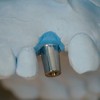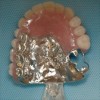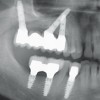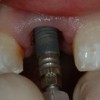There are several advantages to restoring maxillary defect with an immediate surgical obturator (ISO) immediately following surgical ablation. The ISO provides a matrix upon which the surgical packing can be placed, it reduces contamination of the surgical wound, and it enables relatively normal speech and swallowing in the immediate postoperative period. It also lessons the psychological impact of the surgery. This program details the design and fabrication of these devices.
Surgical and Interim Obturation — Course Transcript
- 1. Surgical and Interim Obturation John Beumer III DDS, MS Distinguished Professor Emeritus UCLA School of Dentistry This program of instruction is protected by copyright ©. No portion of this program of instruction may be reproduced, recorded or transferred by any means electronic, digital, photographic, mechanical etc., or by any information storage or retrieval system, without prior permission.
- 2. Surgical Obturation -Benefits At most institutions the defect is obturated prosthetically at the time of tumor resection with an immediate surgical obuturator (ISO). There are several advantages to this approach.
- 3. Surgical Obturation -Benefits Provides a matrix upon which the surgical packing can be placed Reduces contamination of the surgical wound immediately postoperatively Enables relatively normal speech in the immediate postoperative period The ISO:
- 4. Surgical Obturation -Benefits Permits deglutition postoperatively, eliminating the need for a nasogastric tube Lessens the psychological impact of the surgery Reduces the period of hospitalization The ISO:
- 5. The obturator should terminate short of the skin graft mucosal junction. It should be kept simple, lightweight, and inexpensive. It should be perforated in the interproximal areas so the prosthesis can be wired to residual dentition. Normal palatal contours should be reproduced. Basic principles of design and fabrication
- 6. Posterior occlusion should not be established on the defect side. In edentulous patients, it should be designed like a record base, with no replacement teeth. In some instances, the existing complete or partial denture can be adapted for use as an immediate surgical obturator. Basic principles of design and fabrication
- 7. Impressions The impression must extend onto the middle third of the soft palate
- 8. a: Cast obtained and mounted. b,c: Margins of proposed surgical resection outlined on presurgical maxillary cast. d,e,f: Teeth removed and anterior labial portion of the alveolus trimmed. Note the occlusal clearance. g,h: Anterior teeth have been added to this ISO. a b c d e f g h Laboratory Procedures
- 9. Patient presents with a large squamous carcinoma of the left hard palate A cast is made. Note the tumor distorted palatal contours.
- 10. Patient presents with a large squamous carcinoma of the left hard palate Cast is altered to restore normal palatal contours
- 11. Patient presents with a large squamous carcinoma of the left hard palate Note the nature of the extension through the hamular notch and onto the soft palate (arrows).
- 12. An immediate surgical obturator (ISO) for another patient Note the reduction of the anterior alveolus and the extension through the hamular notch and onto the soft palate. Overextension through the hamular notch will cause significant discomfort postoperatively . Anterior teeth can be added for esthetics The anterior extension of the ISO should not extend labial to the preexisting contours of the alveolus and the anterior teeth.
- 13. Radical Maxillectomy Defects The mucosal side of the incision may dehisce, leading to the obvious lip deformity Results of over contoured anterior extensions of the ISO .
- 14. Radical Maxillectomy Skin incisions (Weber-Fergusson) are used to expose the maxilla to be resected. Oral mucosal incisions are made through the palate and the buccal vestibule. Bony cuts are made through the palate, alveolar ridge, lateral nasal bones, floor of the orbit, malar eminence, pterygoid plates and zygomatic arch. After the remaining soft tissues are detached and removed with the specimen, the raw tissues of the defect are lined with a split thickness skin graft. The skin incision is then closed.
- 15. Radical Maxillectomy The surgical specimen is removed and the immediate surgical obturator (ISO) is placed in position. In this patient it was wired to residual dentition. The prosthesis serves as a platform for the surgical packing. When the wound is closed the facial contours are nearly normal
- 16. Buccal inlay technique Primarily used in total palatectomy defects Requires that the ISO be border molded at surgery. Black gutta percha was used here Principle advantage Improved survival of skin grafts More profound soft tissue undercuts
- 17. In this edentulous patient the immediate surgical obturator was wired to the alveolar ridge. We prefer not to use the existing denture at this stage. Usually the extension onto the soft palate is insufficient and the denture may be damaged when wiring or securing it to the palate or alveolar ridge.
- 18. Radical Maxillectomy Preop Postop Note the lack of muscular tonus on the resected side represented by the drooping of the facial tissues and the corner of the mouth. Patient presented with an adenoid cystic carcinoma of the right maxillary sinus. Note the proptosis. A radical maxillectomy and orbital exenteration was required.
- 19. Radical Maxillectomy The patient five months later without his obuturator prosthesis (A). Facial nerve function has returned to near normal and the obturator prosthesis restores lip and midfacial contours. A The complete denture and obturator prosthesis has been inserted (B). B
- 20. Interim Obturation Purpose: Serve the patient until the wound has healed and becomes dimensionally stable. In most patients the ISO can be relined with Rim Seal* and anterior teeth added with autopolymerizing acrylic resin. *Rim Seal, Harry J. Bosworth Co., Skokie, IL
- 21. a: ISO removed. Note appearance of skin graft. b, c and d: Upon removal of the surgical packing the ISO is extended into the defect with temporary denture reliner. a b c d Interim Obturation
- 22. a and b: Dynamic bite openers are particularly useful in preventing trismus if the patient is to receive postoperative radiation therapy. a b Trismus : Particularly a concern if patient is to receive postoperative radiotherapy
- 23. a and b. Typical border defect. More frequent adjustments are expected. c and d: Soft palate margin of resection is subject to rapid contraction anteriorly and superiorly during first three weeks following surgery. On rare occasions velopharyngeal closure can be compromised. a b c d a a Tissue Contracture – Border Defects
- 24. Interim Obturation Purpose Enable speech and swallowing during the immediate postoperative and healing periods In edentulous patients the existing denture can be relined with a temporary denture reliner and used as an interim obturator. In this patient Rim Seal* was used. * Rim Seal, Harry J. Bosworth Co., Skokie, IL
- 25. Interim Obturation The patient’s existing denture required significant modification to serve as an interim obturator * Rim Seal, Harry J. Bosworth Co., Skokie, IL The posterior extension onto the soft palate was developed with Rim Seal* (arrows). The anterior flange of the denture on the defect side needed to be shortened significantly and this area remolded with Rim Seal* (oval).
- 26. a; Maxillectomy defect 1 month post surgery. b and c: Centric relation record made, posterior teeth added and the prosthesis relined, rebased and reinserted. d and e: Prosthesis in position . a b c d e Interim Obturation
- 27. Visit ffofr.org for hundreds of additional lectures on Complete Dentures, Implant Dentistry, Removable Partial Dentures, Esthetic Dentistry and Maxillofacial Prosthetics. The lectures are free. Our objective is to create the best and most comprehensive online programs of instruction in Prosthodontics


 Cement Retention vs Screw Retention
Cement Retention vs Screw Retention
 Implants and RPDs
Implants and RPDs
 Restoration of Posterior Quadrants and Treatment Planning
Restoration of Posterior Quadrants and Treatment Planning
 Single Tooth Defects in Posterior Quadrants
Single Tooth Defects in Posterior Quadrants
